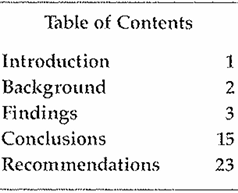
Hierarchical Headings
 المؤلف:
BARBARA MINTO
المؤلف:
BARBARA MINTO
 المصدر:
THE MINTO PYRAMID PRINCIPLE
المصدر:
THE MINTO PYRAMID PRINCIPLE
 الجزء والصفحة:
174-10
الجزء والصفحة:
174-10
 2024-09-28
2024-09-28
 829
829
Hierarchical Headings
Essentially, the technique for using hierarchical headings is to place signs for increasingly subordinate ideas ever further to the right of the page, and to treat ideas at the same level in the same visual form (Exhibit 56).
Thus, major ideas are capped with major section headings at the left-hand margin, divisions of these major ideas are capped with subsection headings, divisions of those with numbered paragraphs, and so on. The style of heading you choose need not necessarily follow this particular form, of course, but whatever the form, each heading should represent a division of thought.
To that end, you will want to take care that you:
1- Never use only one of any element. Since the headings indicate levels oi abstraction in the pyramid, you can never have only one item at any level. Thus, you can never have only one major section, or one subsection, or one numbered paragraph, or one dash point. Put more plainly you shouldn't just stick in a heading because you think it would look good on a page, the way newspapers and magazines do, to break up the printing. A heading is meant to call attention to the fact that the idea it represents is one oi a group, all oi which work together to explain or defend the overall thought they support.
2. Show parallel ideas in parallel form. Since all the ideas in a group are the same kind of idea, you want to emphasize this sameness by using the same grammatical form for the wording of each heading, etc. Consequently, if the first idea in a group of major section headings begins with a verb, all the rest must as well; if the first idea in a group of subsection headings begins with an "ing" word, so should all the others:
Appoint a Full-Time Chief Executive
To Coordinate Activities
To Effect Improvements
Establish Clear Lines of Authority
Regrouping Hotels by Support Needs
Assigning Responsibility for Overseas Operations
Removing Boards from the Chain of Command
As you can see, because the subsection headings in the first group begin with the word "To" does not necessarily mean that those in the second group must do so as well. Remember that there are invisible fences imposed between the ideas in each major section. Thus, the parallelism to be emphasized is between ideas in the sub-section group, not between groups of subsections.
3. Limit the wording to the essence of the thought. The headings are meant to remind, not to dominate. Thus, you want to make them as concise as possible. You would not want, for example, to make the first major section heading above read "Appoint a Full-Time Chief Executive to Provide Clear Central Authority." That is way too many words for the purpose.
4. Regard heading as outside the text. Headings me for the eye more than they are for the mind. As a result, they are not often read carefully, and you cannot depend on them to carry your message as part of the text. Don't, for example, say:
Appoint a Full-Time Chief Executive
This action will go far toward clarifying the day-to-day responsibilities of…
Instead, you need to make sure that your opening sentence under a heading indicates that you are turning to a new topic. In fact your entire document should be able to be read as a smooth-flowing piece without the headings. This rule, however does not apply to numbered paragraphs, which are meant to be read as part of the text.
5. Introduce each group of headings. In doing so, you want to state the major point that the grouping will explain or defend as, well as the ideas to come. To omit this service is to present the reader with a mystery story, since he will then not be able to judge what the points are you are trying to make in that section mil he gets to the end-and by then he may well have forgotten the beginning. For this reason, you should never have a major section heading begin immediately after the title, nor should you ever have a subsection heading begin immediately after the section heading.
6. Don't Overdo. This is perhaps the most important rule of all. You want to use headings only if they are going to help to clarify your message-if they are going to make it easier for the reader to keep the subdivisions of your thought in his head. Often it is not necessary or useful to have any division below the major section headings.
If you formulate your headings properly, they will stand in the table of contents as a precis of your report--another extremely useful device for the reader in trying to come to terms with your thinking. You can get an idea of the communicating value of this from the headings under point 2 opposite. You can also, of course, see that this technique will work only if you have made sure to put real ideas in the boxes in your pyramid. It is of no value to the reader in communicating your thinking if you give him a table of contents that reads as follows:

You would in any case generally not need a heading called "Introduction" or "Back-ground" as part of a report. To begin with, they overlap because both contain introductory information. In addition, they are unnecessary-what else would the first few paragraphs of the document be? Headings are meant to show divisions of thought, and the "thought" in the above example does not begin mil one gets to the Key Line level, which theoretically begins here with the "Findings."
 الاكثر قراءة في Writing
الاكثر قراءة في Writing
 اخر الاخبار
اخر الاخبار
اخبار العتبة العباسية المقدسة


